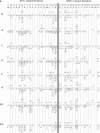Impact of HIV-1 subtype and antiretroviral therapy on protease and reverse transcriptase genotype: results of a global collaboration
- PMID: 15839752
- PMCID: PMC1087220
- DOI: 10.1371/journal.pmed.0020112
Impact of HIV-1 subtype and antiretroviral therapy on protease and reverse transcriptase genotype: results of a global collaboration
Abstract
Background: The genetic differences among HIV-1 subtypes may be critical to clinical management and drug resistance surveillance as antiretroviral treatment is expanded to regions of the world where diverse non-subtype-B viruses predominate.
Methods and findings: To assess the impact of HIV-1 subtype and antiretroviral treatment on the distribution of mutations in protease and reverse transcriptase, a binomial response model using subtype and treatment as explanatory variables was used to analyze a large compiled dataset of non-subtype-B HIV-1 sequences. Non-subtype-B sequences from 3,686 persons with well characterized antiretroviral treatment histories were analyzed in comparison to subtype B sequences from 4,769 persons. The non-subtype-B sequences included 461 with subtype A, 1,185 with C, 331 with D, 245 with F, 293 with G, 513 with CRF01_AE, and 618 with CRF02_AG. Each of the 55 known subtype B drug-resistance mutations occurred in at least one non-B isolate, and 44 (80%) of these mutations were significantly associated with antiretroviral treatment in at least one non-B subtype. Conversely, of 67 mutations found to be associated with antiretroviral therapy in at least one non-B subtype, 61 were also associated with antiretroviral therapy in subtype B isolates.
Conclusion: Global surveillance and genotypic assessment of drug resistance should focus primarily on the known subtype B drug-resistance mutations.
Conflict of interest statement
Figures







Comment in
-
HIV-1 subtype and reverse transcriptase genotype: role for geographical location and founder effects.PLoS Med. 2006 Dec;3(12):e540. doi: 10.1371/journal.pmed.0030540. PLoS Med. 2006. PMID: 17194205 Free PMC article. No abstract available.
References
-
- Gao F, Bailes E, Robertson DL, Chen Y, Rodenburg CM, et al. Origin of HIV-1 in the chimpanzee Pan troglodytes troglodytes . Nature. 1999;397:436–441. - PubMed
-
- Hahn BH, Shaw GM, De Cock KM, Sharp PM. AIDS as a zoonosis: Scientific and public health implications. Science. 2000;287:607–614. - PubMed
-
- Korber B, Muldoon M, Theiler J, Gao F, Gupta R, et al. Timing the ancestor of the HIV-1 pandemic strains. Science. 2000;288:1789–1796. - PubMed
-
- Robertson DL, Anderson JP, Bradac JA, Carr JK, Foley B, et al. HIV-1 nomenclature proposal. Science. 2000;288:55–56. - PubMed
-
- Osmanov S, Pattou C, Walker N, Schwardlander B, Esparza J. Estimated global distribution and regional spread of HIV-1 genetic subtypes in the year 2000. J Acquir Immune Defic Syndr. 2002;29:184–190. - PubMed
Publication types
MeSH terms
Substances
Associated data
- Actions
- Actions
- Actions
- Actions
- Actions
- Actions
- Actions
- Actions
- Actions
- Actions
- Actions
- Actions
- Actions
Grants and funding
LinkOut - more resources
Full Text Sources
Medical
Molecular Biology Databases

